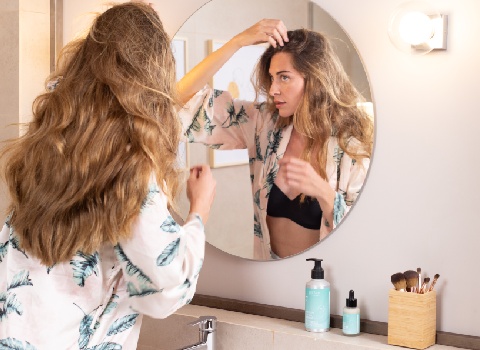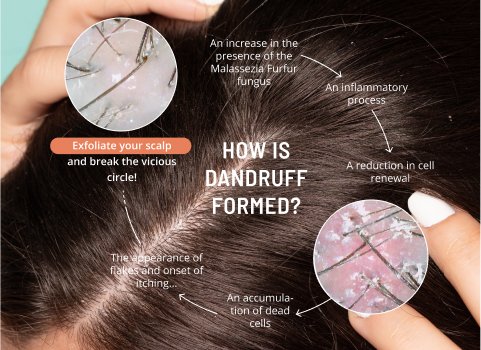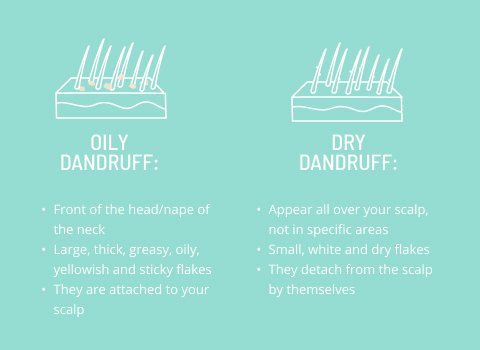Dandruff & Scalp Exfoliating Treatment
Natural scalp peeling - 50ml
Not sure what to look for? You can start from here:

Here are your essentials
for making it this far
Do you ever feel insecure when you wear black clothes and then see those pesky white dandruff specks appearing everywhere? Looking to avoid such a situation, no matter the cost? We thought so! The reality is that dandruff is a more common condition than you might think, in fact, 50% of the population has dandruff, and all that comes with it; scalp irritation, flakes, itchiness... but ...where does it come from? When did my hair change and when did I begin to get dandruff? And how can I prevent it?...
We know that you have many concerns, and that's why we're here. We want to help you solve those problems, and we'll start off by saying that most of them have to do with scalp exfoliation. Do you know what we mean? Continue reading.
Moreover, please hang tight because we're also going to debunk some myths about dandruff... for example, I'm sure you've always thought that dandruff is something that only affects dry hair, and that the dryness of the scalp is what generates those flakes that we refer to as "dandruff". Well, we're afraid that this is not entirely true, there are two types of dandruff and oily hair can also suffer from it. Continue reading to find out more...
Dandruff is a skin condition on the scalp that causes itching, irritation and flaking - but you already knew that and what it looks like, right? But... why does this condition develop on the scalp? It's simple! Because of a dysbiosis of the hair's ecosystem, or, in other words, because of an imbalance in the microbiota of the scalp. And what's the microbiota? A set of microorganisms (bacteria, fungi, viruses and parasites) found on your scalp, which, when their balance is disturbed (in addition to changes in the pH of your scalp), causes an inflammatory reaction which leads to itching and flaking. And, as a result, dandruff will appear.

In short, what happens when the microbiota becomes unbalanced is that the "dreaded" dandruff makes an appearance.
The main cause of dandruff is the previously mentioned imbalance in the microbiota, mainly due to an excess of the Malassezia Furfur fungus. In short, this fungus breaks down the sebum in the hair, triggering inflammation and causing itching.
Under normal conditions, the Malassezia fungus breaks down the sebum on the scalp, transforming the lipids into simple fatty acids, as this fungus is not able to produce the fatty acids necessary for its growth. This is how the fungus should function on your scalp. But when the microbiota is altered, there is an explosion of Malassezia, which upsets the ecosystem's balance and triggers an inflammatory reaction on the scalp.
As a consequence of this inflammation, cell division increases (a process known as cellular mitosis, in which a cell, the mother cell, divides to produce two new cells that are genetically identical to each other), which augments the number of keratinocytes. This accumulation of cells that begin to shed (keratinocytes) is usually manifested as flaking and/or dandruff, as well as redness and itching. Something that, therefore, also has to do with cell turnover.
Skin that functions properly has a 24 to 30-day cell turnover cycle, but when dandruff appears, this process is shortened and occurs every 17 to 20 days. As a result, more dead cells (keratinocytes) accumulate on the scalp, which look like white flakes (dandruff).

Once you've reached the point where cell turnover starts to occur, it becomes clear that scalp exfoliation is the key to reducing and improving irritation, itchiness and, ultimately, dandruff. But first, you may be wondering what causes the Malassezia Furfur fungus to thrive in such a way that it disrupts the balance of your microbiota. Some of these causes are listed below.
Did you think that there was only one type of dandruff? Or that dry scalps were the only ones that could get dandruff? Well, let's debunk that myth! There are actually 2 types of dandruff on the scalp and they have a lot to do with your hair type - dry hair and oily hair:

1- Dry dandruff. This can look like fine, dry, whitish flakes that fall off easily and cover the entire scalp area. The scalp is somewhat dry, but there are no signs of inflammation or itching. The hair is rough, lifeless and dull. This type of dandruff, although it may disappear on its own, if not treated correctly, usually lasts for a long time.
2- Oily dandruff. Oily dandruff is characterised by flaking associated with seborrhoea or excess oil. It is predominantly located in the most seborrheic areas of the head, such as the forehead and nape of the neck. The scales are larger, thicker, oily, yellowish and sticky and tend to adhere to the scalp and hair to form plaques. The scalp often becomes erythematous, itchy and inflamed. It is often associated with seborrhoeic dermatitis.
In order to alleviate dandruff, the scalp needs to be exfoliated. Why? Because it will remove dead cells, excess oil and residues that accumulate over time, as well as improve cell turnover. But we also need active ingredients that help us to reduce the excess growth of the Malassezia fungus, to effectively fight inflammation, irritation, itching and, ultimately, dandruff.
But how? Are there specific exfoliators for the scalp? Of course there are! But, to make things easier, we recommend exfoliators that are free of microparticles (scrubs), as the latter are more difficult to remove and rinse off. Alternatively, alpha hydroxy acids, also known as AHAs, are exfoliating agents that dissolve the bonds between dead skin cells and help to remove the flakes that remain embedded in the skin. Furthermore, these types of exfoliants are usually applied as a serum or treatment, left on for a few minutes and easily removed when you wash your hair.
Which ingredients are the most suitable if my scalp is fragile or sensitive? Lactic acid is the most gentle of the alpha hydroxy acids (AHA). It's perfect for sensitive skin. As we've already mentioned, dandruff causes inflammation, so it's important to use active ingredients that are suitable for the most reactive and fragile skin types.
So how do you treat Malassezia Furfur fungus? Continue reading...
Is it possible to outsmart the dandruff-causing fungus Malassezia Furfur? The Dandruff & Scalp Exfoliating Treatment is a natural scalp exfoliator with the first-ever natural active ingredient that acts directly on the enzymes that cause dandruff, the Malassezia fungus. How? By harnessing this micro-organism's dependence on lipids, it mistakenly recognises this active ingredient as such, thus triggering self-regulation and reducing flaking of the scalp.
Furthermore, this natural scalp exfoliator is formulated with the lactic acid we mentioned earlier and other specific natural ingredients to reduce irritation and itching, leaving an amazing sensation of freshness and a welcomed feeling of relief for your head. So you have a better idea, it's like taking out your high ponytail after wearing it all day, or like a relaxing massage when your back or neck is feeling particularly heavy... Phew, what a relief!
Freshly wants to tell you something! At Freshly we keep on learning every day how to make decisions that bring us closer to a better future. Sometimes we are called dreamers, but what we really have is an optimistic vision and clear path for reaching that tomorrow.
Would you like to join this adventure? If you're here, it's because you are a demanding person when it comes to taking care of your body and the planet. By subscribing to the newsletteryou will receive articles like this one to continue learning, as well as news and exclusive discounts. Are you up for it?